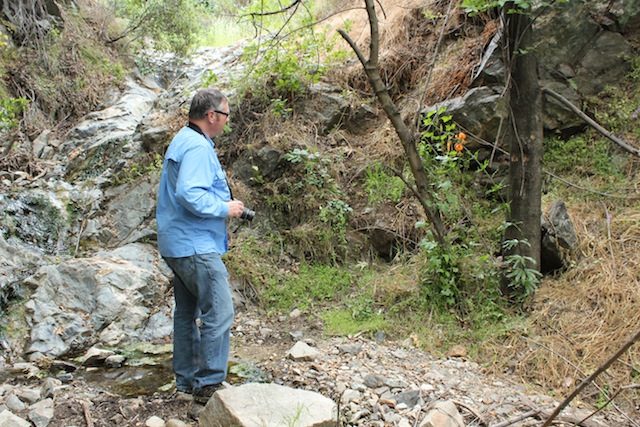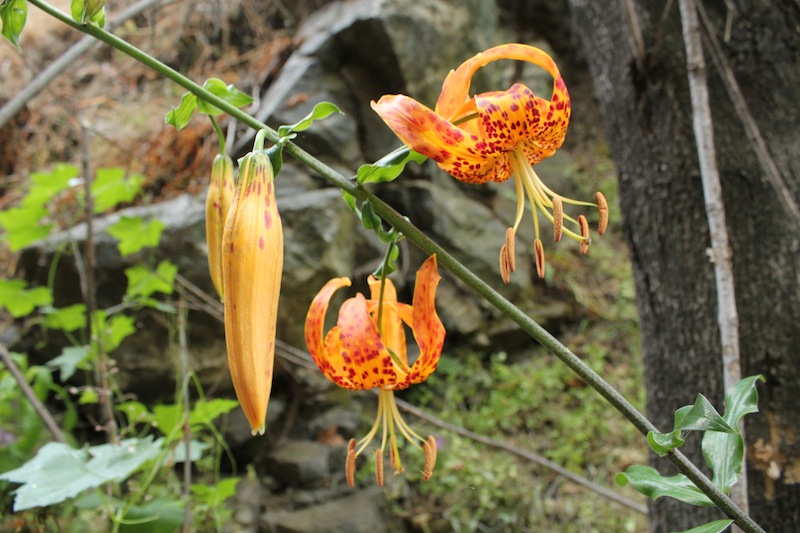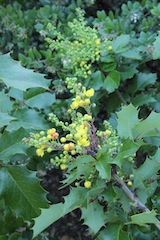In praise of Bart O’Brien
Posted on | November 14, 2013 | 7 Comments

Rancho Santa Ana horticulturist Bart O’Brien spots a Humboldt lily during a hike in La Tuna Canyon, Los Angeles County.
Expecting a generous reaction to the news that Bart O’Brien is taking over directorship of the Regional Parks Botanic Garden in the Bay Area’s Tilden Park asks too much of an Angeleno. Berkeley’s gain is a staggering loss for Southern California, specifically for the Rancho Santa Ana Botanic Garden, where O’Brien has worked for more than 20 years. As Rancho’s director of horticulture, and later leader of its special projects, O’Brien introduced generations of homeowners and no few directors of water companies to plants perfectly adapted to our dry climate. The importance of this work cannot be overstated. These stoic plants and not squelching lawn will green our cities as more people are faced with getting along on less water.
The native plant movement was far from new when O’Brien arrived in Southern California from a noted northern California nursery in the spring of 1990. Los Angeles nurseryman Theodore Payne had done much to promote the beauty of native plants and wildflowers as early as 1905. By the 1920s, as developers chewed through the region’s woodlands and chaparral, Payne and no less than the father of American landscape architecture, Frederick Law Olmsted, Jr, had worked with an Orange County heiress to establish the original Rancho garden in Santa Ana as a sort of Noah’s Ark for native plants. Native gardening even gained a kind of Ivy League cache when the Santa Ana garden was moved to its present 86 acres near the Claremont Colleges in the 1950s.
But outside of specialist circles and rarefied collections, native gardening remained a stubbornly niche concern. When the Hollister-born O’Brien took successive degrees in environmental planning at UC Davis and landscape architecture at Harvard in the 1979s and 80s, Los Angeles was famous for palm trees and bougainvillea, neither of them native. When he joined Rancho in March, 1990, the challenge was showing that our local plants were as gorgeous as any exotics. Achieving this involved massing the plants for effect. “Most gardens can only display one or two of something,” he said. “Here at Rancho, we can do 50 to 100.”
As he created mouthwateringly beautiful vistas, one might be filled with glossy hedges laden with berries and bell-shaped flowers. Another might offer up a small field of flax-like blue rye, deer grass, coyote bush and California fuchsia studded with white sage.
While creating these tableaux, O’Brien and Rancho staff continued the founders’ tradition of selecting the best cultivars to propagate for trade. One of many introductions made under O’Brien was Salvia ‘Betsy Clebsch’. It’s easy to forget that when you buy a California sage or lilac with just the right blueness of flower, just the right sweetness of scent and just the right greenness of leaf, years of testing and discarding not quite the right ones has gone on to make the plant you are holding in a nursery pot possible.
Anticipating what plants would be suitable for home gardens involved getting to know home gardeners. The second Thursday of every month, O’Brien could be found in Friendship Auditorium in Griffith Park attending Southern California Horticultural Society meetings. During breaks, there was often a line to speak to O’Brien. No question was too stupid or gardener too humble. Garden writer Lili Singer soon had O’Brien writing — on sages, if memory serves — for her highly regarded newsletter. By 2000, O’Brien was one of the contributors to the cult Southern California Horticultural Society book “Selected Plants for Southern California Gardens.” Edited by the San Fernando Valley gardener, librarian and raging eccentric Joan Citron, this deliciously quirky book contained plant descriptions followed by remarks from a cohort of gardeners each of whom lived in distinct climate zones between LA’s coast and mountains. “We were identified quasi-geographically. ‘Inland and MT Baldy’ was me,” says O’Brien. Comments were often helpful (such as: “can be clipped like a hedge”) and just as often rueful (such as: “This was never as showy as I expect it to be” or “sulked and turned chlorotic” or “much too spiny and dangerous for most gardens.”)
Two years after “Selected Plants…” appeared, in 2002, drought gripped the Colorado River just as California also faced sharp reductions forced by competing water users in Nevada and Arizona. O’Brien helped to partner Rancho with the Metropolitan Water District of Southern California, which launched the ill-fated “California friendly” plant movement. O’Brien went on to work with Inland Empire water companies and Home Depot to make native plants accessible outside of specialist nurseries. The landscape water conservation movement was making great strides when in 2010 and 11 internecine battles waged by Metropolitan’s board led to such erratic funding that Rancho’s program was cut. To the chagrin of those behind the Met experiment, the Southern Nevada Water Authority, an arch rival of Southern California, adopted the idea of landscape reform, customized it for the Mojave Desert and is now a world-renown beacon for outdoor water efficiency.
It was the 2006 publication by Cachuma Press of “California Native Plants for the Garden” co-authored by O’Brien with David Fross, the founder of Native Sons nursery, and Carol Bornstein, then-director of the Santa Barbara Botanic Garden, that finally washed away at least some of the stink of worthiness and made Southern Californian native gardening seem sexy in its own right. Finally there was a simple compendium showing how carefully bred cultivars of native plants, from ground cover to shade trees, could be used to landscape homes, businesses and parks. In 2006, the Cachuma book was honored by the American Horticultural Society, a body that insofar as it thought about California at all had largely viewed Los Angeles as a place where you could grow Eastern plants in the winter.
The Cachuma book, then a spin-off volume, lectures and a project involving Baja plants led to a shift for O’Brien from director of horticulture to special projects head. Stepping aside from hands-on running of the garden spared O’Brien the worst of the disquiet when a new executive director appointed to run Rancho in 2005 carried out staff reductions, hired a director of horticulture unfamiliar with California flora and embarked on a bold new bid to sustain a large West Side nursery. However, O’Brien says that his decision to return north has nothing to do with any passing executive turbulence and everything to do with a long-time love-affair with the Tilden garden. “It’s a horticultural gem,” says O’Brien. “I knew Wayne Roderick, who was director when I first went there. I know the current director Steve Edwards. Steve had told me that he was going to retire and he really wanted me to be his successor. I was very flattered and it just worked out.” He also, he says, longs “to get back in the garden.”
It’s too soon to be happy for Tilden. But it may also be too soon to mourn as grievously as I have been doing. Rancho’s new director of horticulture, Scott LaFleur, is now free to run the show without an elder statesman overshadowing him. When O’Brien leaves Rancho at the end of this month, we in Southern California will have been left with a beautifully restored and showcased Claremont garden, two cult books and water agencies that can no longer argue about the efficacy of landscape reform. O’Brien’s great legacy must be that he has shown how much a single horticulturist can do for his or her city and region.
For that, we must wish O’Brien well. Dammit.
Click here for a history of Rancho Santa Ana Botanic Garden and detailed horticultural notes from its collection edited by O’Brien.
11/17/13: This article has been lightly edited and photos have been added since the original posting. All photos by Emily Green.
Tags: Bart O'Brien > chance of rain > Emily Green > Rancho Santa Ana Botanic Garden
Comments
7 Responses to “In praise of Bart O’Brien”
Leave a Reply










November 14th, 2013 @ 8:16 pm
Well written Emily – as always.
There are only a handful of garden and plant icons in Southern California and Bart C’Brien is one of those.
I know we’re supposed to be happy for Bart. I’m trying.
November 15th, 2013 @ 6:35 am
I’m so glad to know him for many years and to count him among my friends. While I’m happy for Bart, I’m very sad for us. Tilden’s great gain is southern California’s great loss. As a credit to his legacy at RSABG, he’s left us with a framework for native plant uses and appreciation. It’s up to us to carry on.
To help us all out, I propose a new phone number for him: 1-800-HEY-BART so we can call on him at any time ;7)
November 15th, 2013 @ 9:39 am
Bart is a man I know through his books and the beauty of the garden, not personally. Nonetheless, I feel as though I’ve lost a relative! Yes, it is lucky for Tilden, a glorious garden that is an old friend of my heart and senses but it also is very sad for Southern California. Bart O’brien is a hero. I will plant a native plant today to commemorate the gifts of this great man to the plant palette that I use regularly. Thank you for writing this!
November 16th, 2013 @ 5:09 pm
I was late to last Thursday’s SoCal Hort mtg when he was bid goodbye, so really appreciate this in-depth tribute.
November 20th, 2013 @ 12:37 pm
Bart is an inspiration to us all – knowledge, passion and personality. Tilden adds a gem to its crown.
December 9th, 2013 @ 11:32 am
Great article, Emily, thanks.
January 15th, 2014 @ 9:53 pm
I’ve know Bart for many years from the Southern Cal horticulture society meetings and dinners before with the speaker. At the meetings I would help him during the plant show and tell, where I was able to learn more about the plants that were brought in. And then later when I was hired at Rancho’s Grow Native Nursery at the VA in West LA, Bart was instrumental in starting and the new nursery and stocking the wonderful plants.
I will miss his wonderful knowledge and great laughs, he is one of he top horticulturist in both North and Southern Calif. Thank you for writing this, Emily. Beautiful.